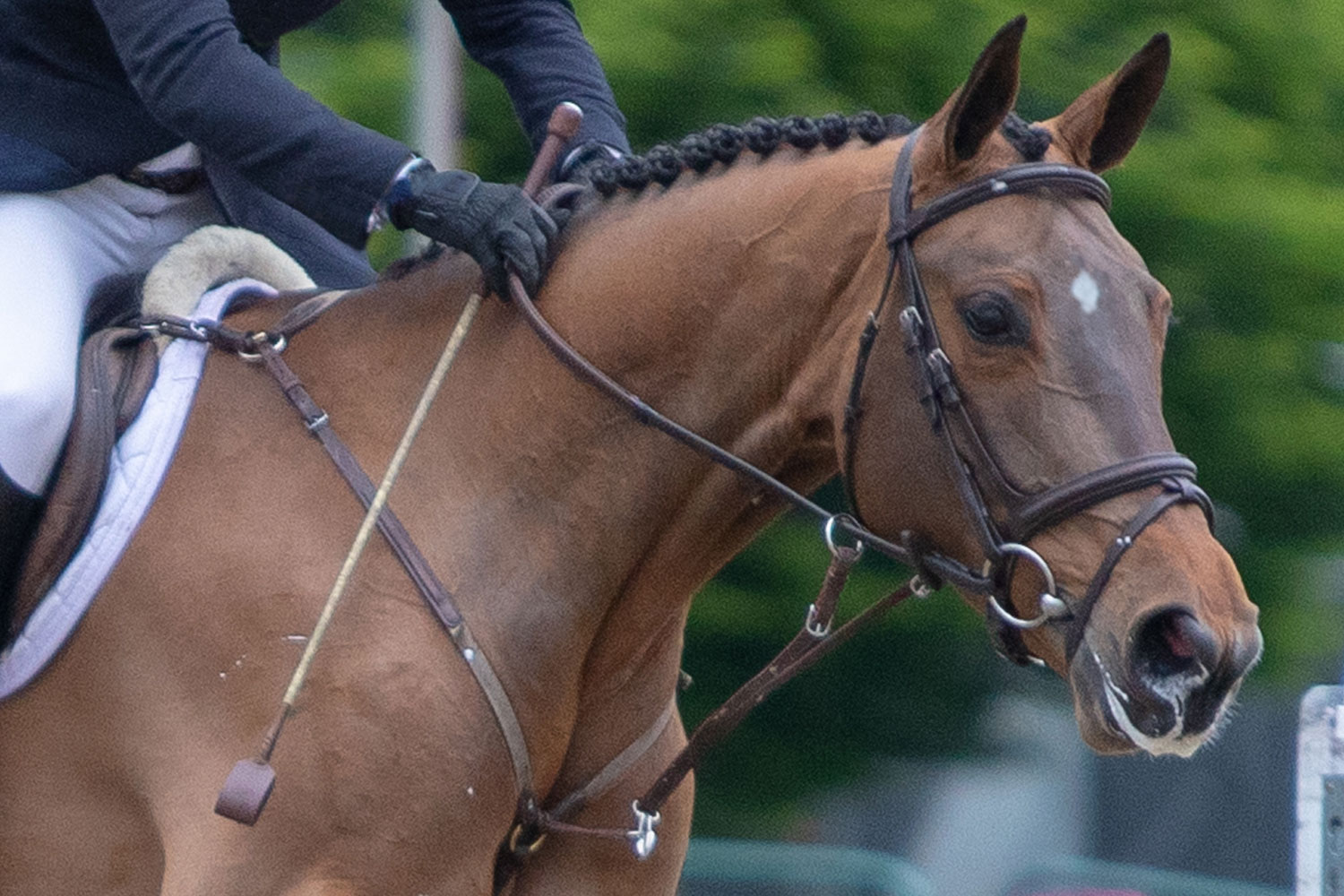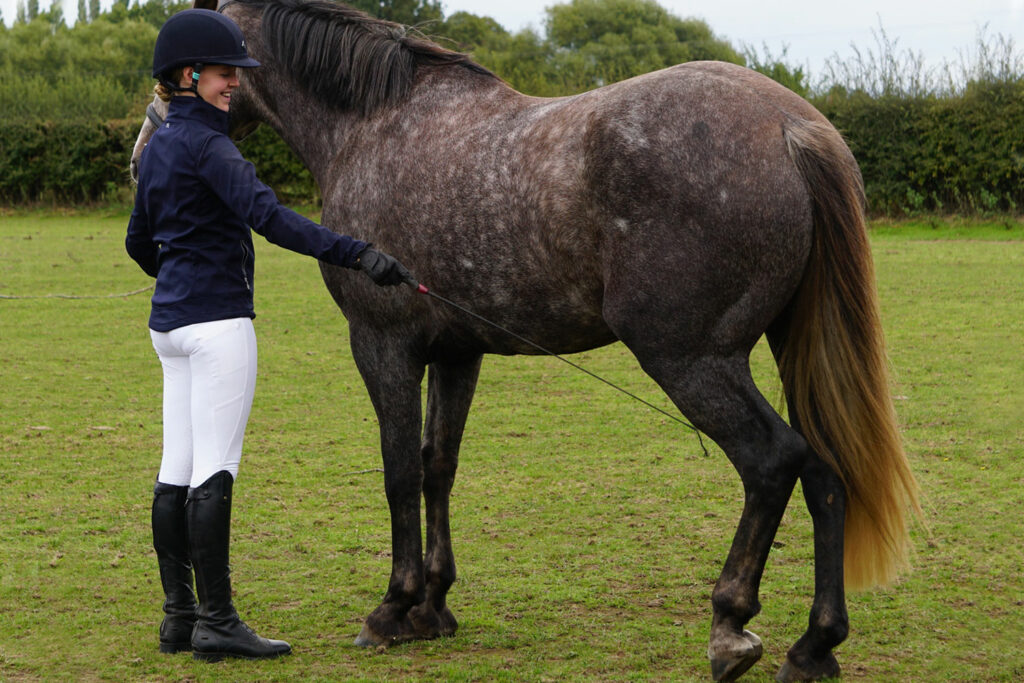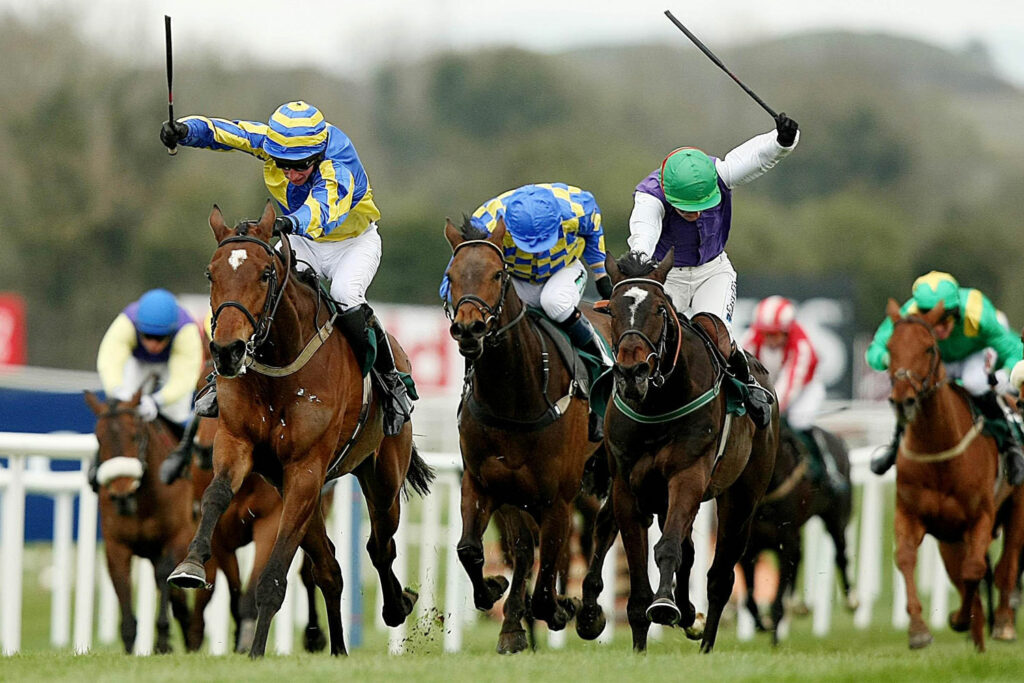With use of the whip becoming an increasingly hot topic, we all need to decide whether this is indeed acceptable – and, if so, why, how, and when?
Posted on 25/07/2024

Use of the whip in horse sport is becoming an increasingly hot topic. In July 2022, the British Horseracing Authority published the results of their consultation on the use of the whip in racing (you can find our response here). This naturally encourages a focus on how the whip is used elsewhere in the horse world.
We believe that we should all ask ourselves three questions before we decide to carry and/or use a whip:
- Should I/do I need to carry a whip today?
- If I am carrying a whip, should I/do I need to use it in this specific situation?
- If I do use the whip, will my horse understand what it means?
We all need to decide whether whip use is acceptable and, if so, why, how, and when? For us at World Horse Welfare, the answers depend on what the horse experiences when the whip is used. There are several aspects to consider, and riders/trainers may find these generate more questions than answers at times.
1) Does the whip cause pain or fear?
The whip can be used in such a way that it is just a minor irritant – a sort of ‘tickling stick’, where the horse’s experience is little different from if we were using our fingers to tap on their skin.

But it can also be used in such a way that the horse will experience pain and/or fear.

Even if there is no contact, a horse’s previous experience may mean that simply waving the whip is enough to induce fear. Intentionally causing pain and fear in animals can never be ethically acceptable. A fearful horse is also likely to be more reactive, and this may reduce both horse and rider safety.
2) Does the horse understand?
It’s vital that the rider/handler understands how horses learn, knows the difference between negative reinforcement (removing pressure when a horse does what is being asked) and positive punishment (punishing a horse for an unwanted behaviour – a strategy that is often unhelpful and always ethically questionable), and understands the crucial importance of correct timing.

Operant conditioning is widely used in the successful training of many species, including dogs and zoo animals. Training of horses is typically based on negative reinforcement and, increasingly, positive reinforcement. Negative punishment is less common. Positive punishment is ethically questionable and often unhelpful.
For use of the whip to be acceptable (either with or without prior use of the leg), the horse must have been taught how they should respond to the rider’s cues (aids). The rider/trainer should also understand that horses do not think like humans and are not capable of making complex connections between events. For instance, some people feel that it is acceptable to punish a horse because ‘he knows what I want him to do – he’s just being stubborn’. This attitude shows that the handler is overestimating the horse’s intellectual abilities – such ‘punishment’ is abuse.
If the horse does not understand why the whip is being used then, for them, being whipped is just some random (and often unpleasant) act on the part of their handler or rider. This is unlikely to build the trusting relationship that we should all be striving to establish with our horses.
3) Is the horse capable of what they are being asked to do?
We should consider whether the horse’s physical ability and stage of training are suitable for what they are being asked to do. For example, is the horse capable of jumping a fence of that size? Are they strong enough to perform high level dressage movements when they are tired at the end of a lesson? If the answer to either of these questions is ‘no’, then the use of any strong cue (aid) cannot be acceptable. Also, just like their riders, horses can make genuine mistakes. Is it reasonable (or helpful) to punish a horse for this?
4) Is the rider/trainer good enough?
Does the rider ride well enough for the horse to be able to understand what they are being asked to do? For example, if the rider uses conflicting cues (aids), such as applying leg and rein pressure at the same time, the horse is likely to become confused. Similarly, the rider may have brought the horse into a fence badly, making it difficult for the horse to jump. It’s also quite possible that the horse’s training has not set them up to understand the cues for more advanced movements. If this is the case, the rider/handler should assess their own knowledge and ability, as well as the horse’s training programme, making changes as necessary, rather than applying the whip to a confused horse.
It’s also important that the person carrying the whip truly understands appropriate whip use, and that they know how horses learn and how to train and ride logically. For example, it is not reasonable to expect a horse to respond to the whip alone unless they have been trained to respond to this cue used alone. In addition, a rider/handler who is fuelled by adrenalin, fear, anger, or the desire to win must be able to overcome these factors when contemplating whether use of the whip is appropriate.
Is the whip effective?
We should always ask ourselves whether using a whip is truly having the desired effect. There is limited evidence on the effectiveness (or otherwise) of whip use in disciplines other than racing – a sport in which, interestingly, there is currently no scientific evidence that using a whip has a beneficial effect on any aspect of performance. Whenever we carry or use a whip, we should consider whether we are just doing so out of habit or for our own reassurance. Or maybe because everybody else does? But, in reality, how likely is it that striking a horse on the shoulder in the last few strides before takeoff increases the chances of them jumping a fence safely? If they do then jump, perhaps they were going to do so anyway and jumped in spite of the whip use, not because of it?
Does the whip improve safety?
We should also consider how use of the whip might affect horse and rider safety. Many people think that carrying a whip helps to keep them safe. This may be the case when, for example, they are riding on the road (although we know of no scientific evidence to either support or refute this). However, scientific evidence does suggest that use of the whip actually decreases safety when jumping. In one well designed study involving jump racing in the United Kingdom, use of the whip significantly increased the risk of the horse falling. In addition, the more frequently the whip was used in the run up to a fence, the higher the risk of a fall. Does this raise questions about the wisdom of whip use by cross country riders on the approach to a fence? Given that fear is likely to make a horse more reactive, can we really conclude that using a whip on a horse in a way that induces pain helps to keep us safe?
We should also think about use of the whip after a fence at which a horse has jumped poorly. Riders often claim that this improves safety at subsequent fences. Is this true? If the horse jumps better afterwards, is it because the whip was used or because the rider has improved their riding? Or did the horse make a genuine mistake at the earlier fence which they do not repeat? Hitting a horse because they have jumped poorly is simply punishment.
Public acceptance of equestrianism
We should also consider the effect of whip use on equestrianism’s ‘social licence to operate’. In other words, does the very act of carrying or using a whip affect public acceptance of our sport? Many ‘horsey’ people would argue that forceful use of the whip on a horse is necessary for safety, better performance, or effective training. But is this just an example of people ‘normalising’ something they’ve been exposed to repeatedly? When considering equestrianism’s social licence, we need to think like ‘non-horsey’ members of the public because – ultimately – without public support, equestrian sport will not survive.
World Horse Welfare’s position on the whip
World Horse Welfare supports the responsible involvement of horses in sport. This includes responsible use of the whip. Although we have long called for an end to whip use for ‘encouragement’ in racing, we are not seeking to stop use of the whip overall. When used humanely, by people who understand how horses learn, the whip can be a useful and ethically acceptable aid to training horses that is no more aversive than hand or leg cues (aids). However, there are people who use the whip in ways that constitute abuse, where the horse is likely to experience substantial pain and fear. This compromises both equine welfare and our sport’s social licence – and it must stop.
Where do we go from here?
Every trainer, handler, rider, and regulatory organisation within equestrianism needs to consider the circumstances under which use of the whip is ethically acceptable. The British Horseracing Authority has just reviewed use of the whip in racing. Other organisations should ideally do the same, revising their rules in accordance with their conclusions. Undoubtedly, more research into use of the whip will be helpful. However, we can all make decisions now, based on existing evidence and our own moral standpoints, about what is acceptable use of the whip.
Topics
Related Blog Posts

Plan for an emergency when you’re not around – help us to help your horse
Deputy Chief Field Officer Jon Phipps has top tips for owners on making plans just in case your horse injures themselves when you’re not there.

How to help a needle-shy horse overcome their fear
Grooms Amy and Emily explain how they work with horses who are nervous with needles before a visit from the vet.
Recommended News Articles

Ponies go from rescue cases to Equifest champions thanks to World Horse Welfare
Rescue ponies Buttercup and Clyde have been transformed into showing champions in just over a year.

Little donkeys shine a light on our Christmas appeal
Abandoned donkey Mia and her foal Peanut take centre stage this Christmas.

Welcoming Pippa Funnell to book-signing at Badminton Horse Trials
Olympic medallist Pippa Funnell will be signing her new children’s books at our stand.
Enjoy reading stories like this?
Join over 65,000 other horse lovers and sign up for our email newsletter

Join over 65,000 other horse lovers and sign up for our email newsletter
Sign me up now